The effects of portfolios on developing writing skills of english major students at Hanoi law university
The primary focus of this study was to examine the effects of portfolios on
enhancing writing skills of English major students at Hanoi Law University. To achieve the
aim, 50 second-year students participating in the study were randomly divided into
experimental and control groups. The experimental group was taught English writing skills
using portfolios while traditional teaching method was applied to the control group. A pretest and a post-test were administered to both groups to measure the differences in students’
writing performances. The results revealed that portfolios had positive impacts on students’
writing skills. The data gained from the questionnaires administered to the students in the
experimental group to identify their perceptions of portfolios on their writing abilities
showed that the majority of them considered portfolios to be effective. Based on the main
findings, a number of recommendations relating to applying writing portfolios were made
to improve the English teaching and learning process.
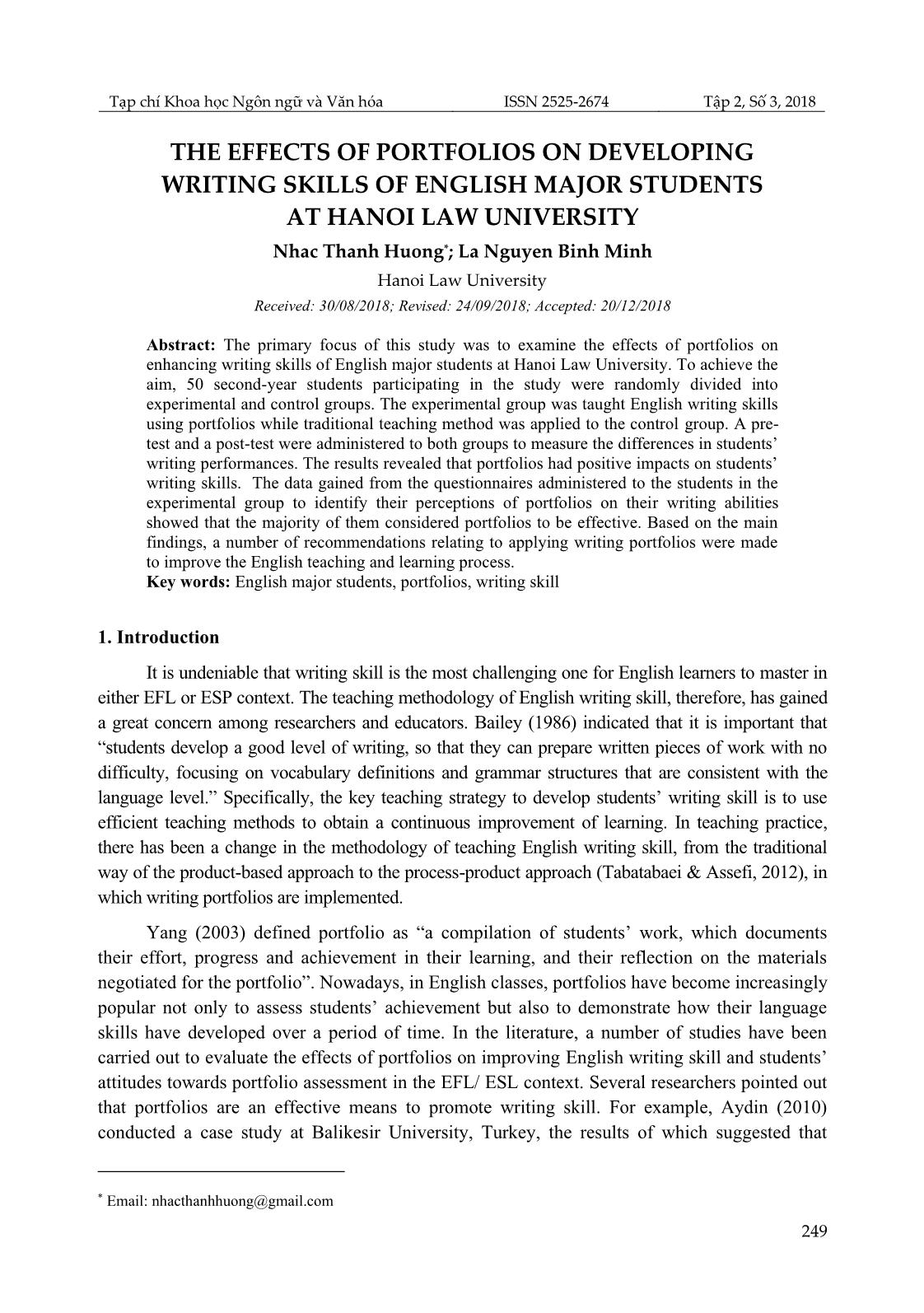
Trang 1
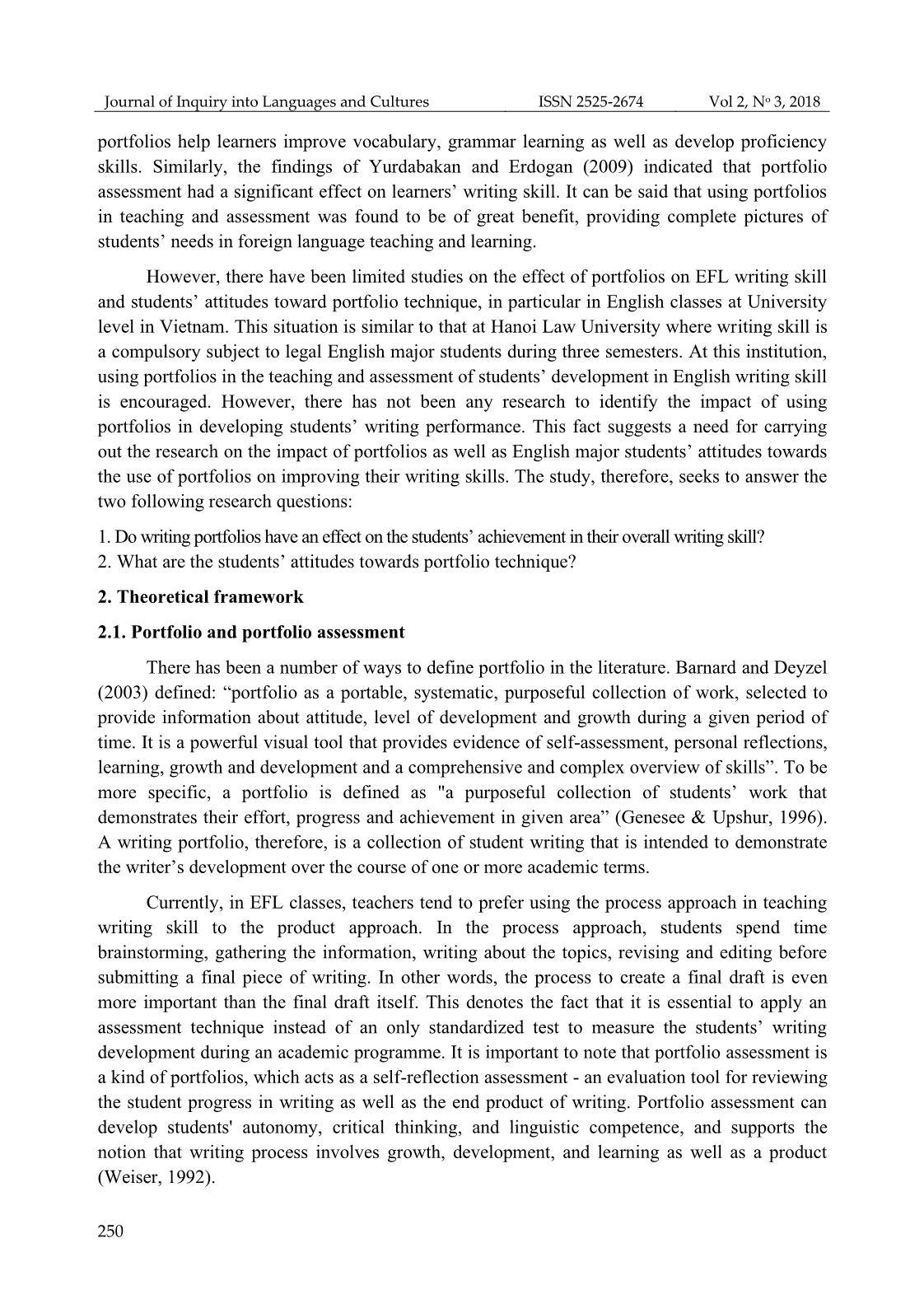
Trang 2
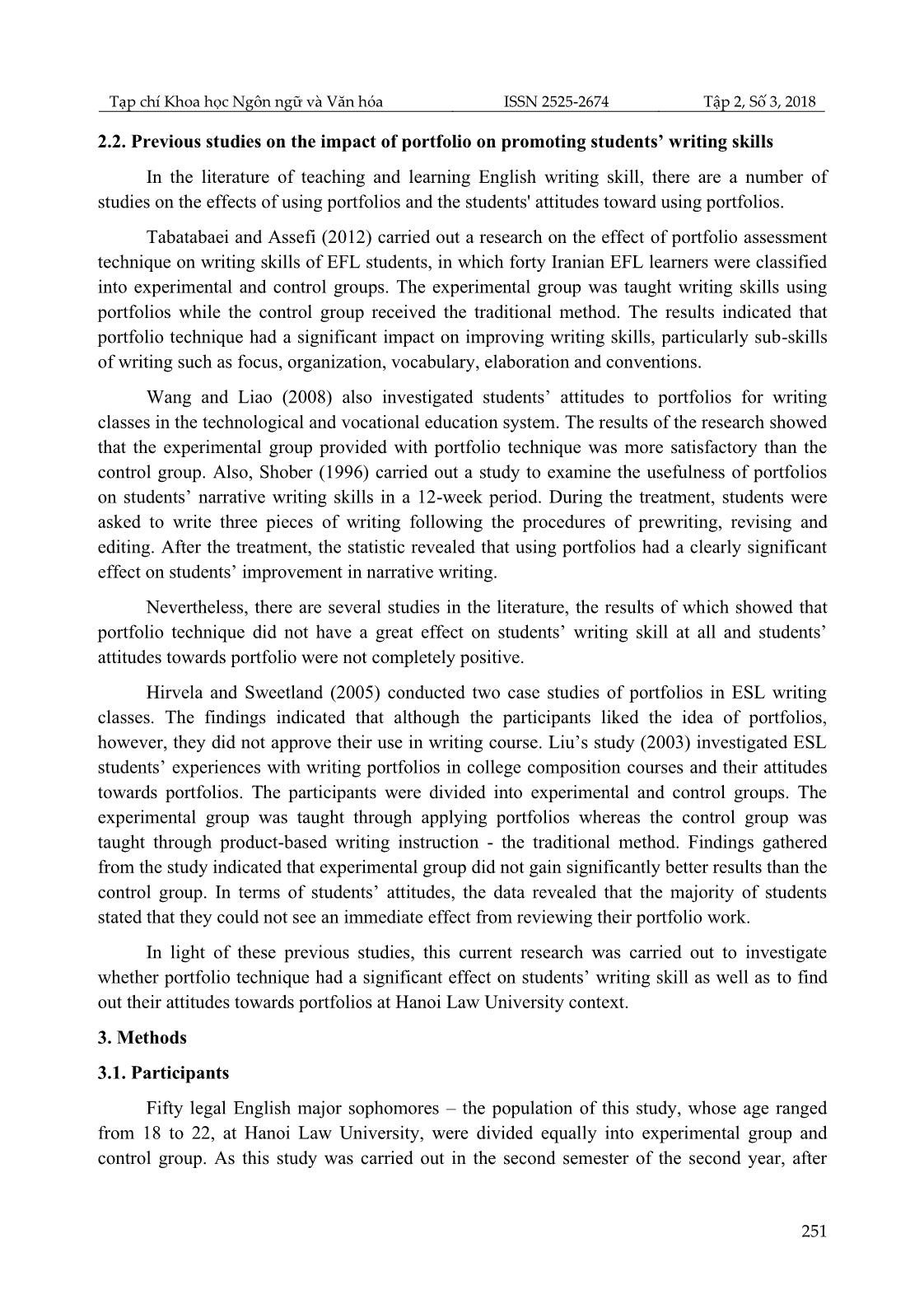
Trang 3
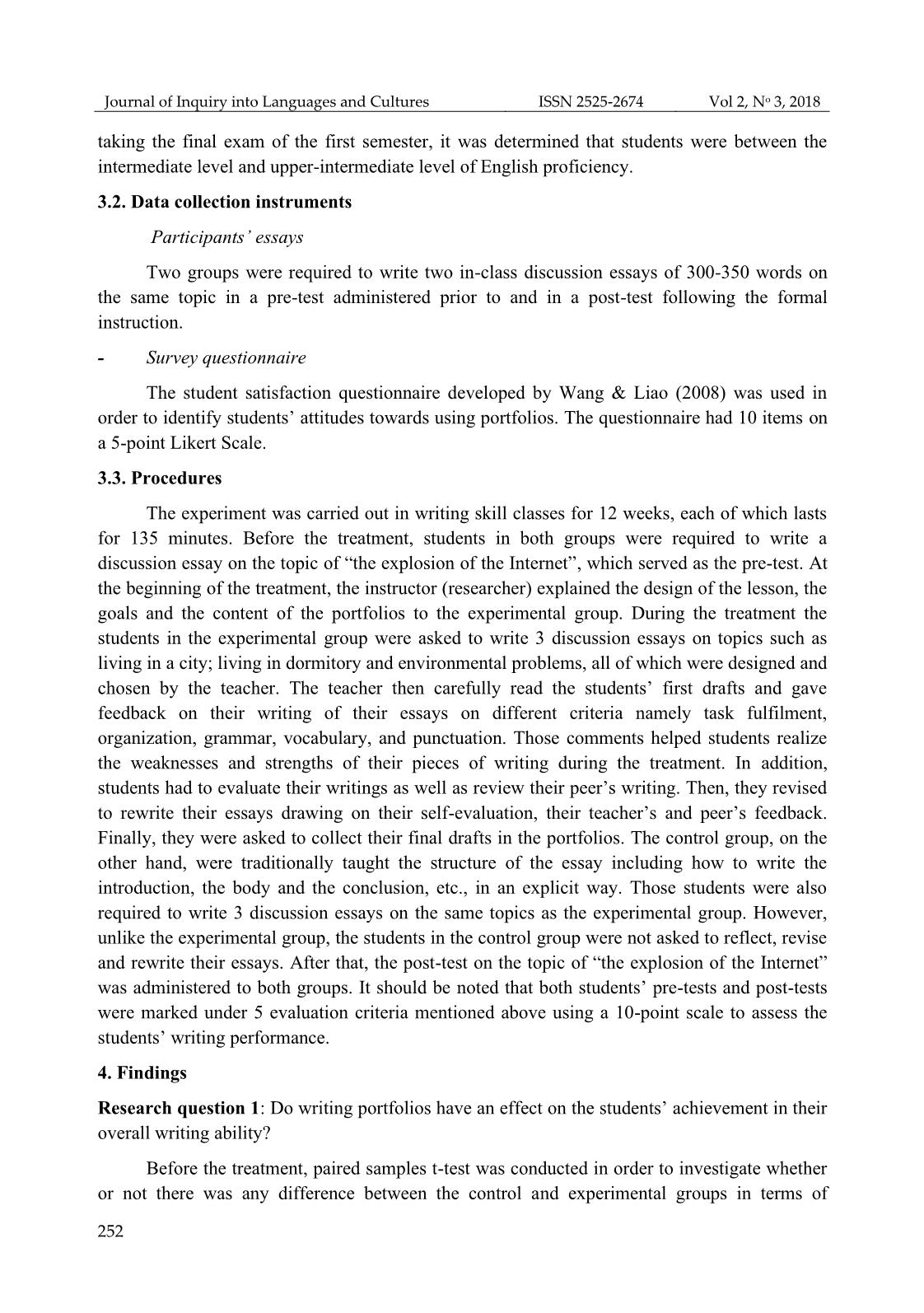
Trang 4
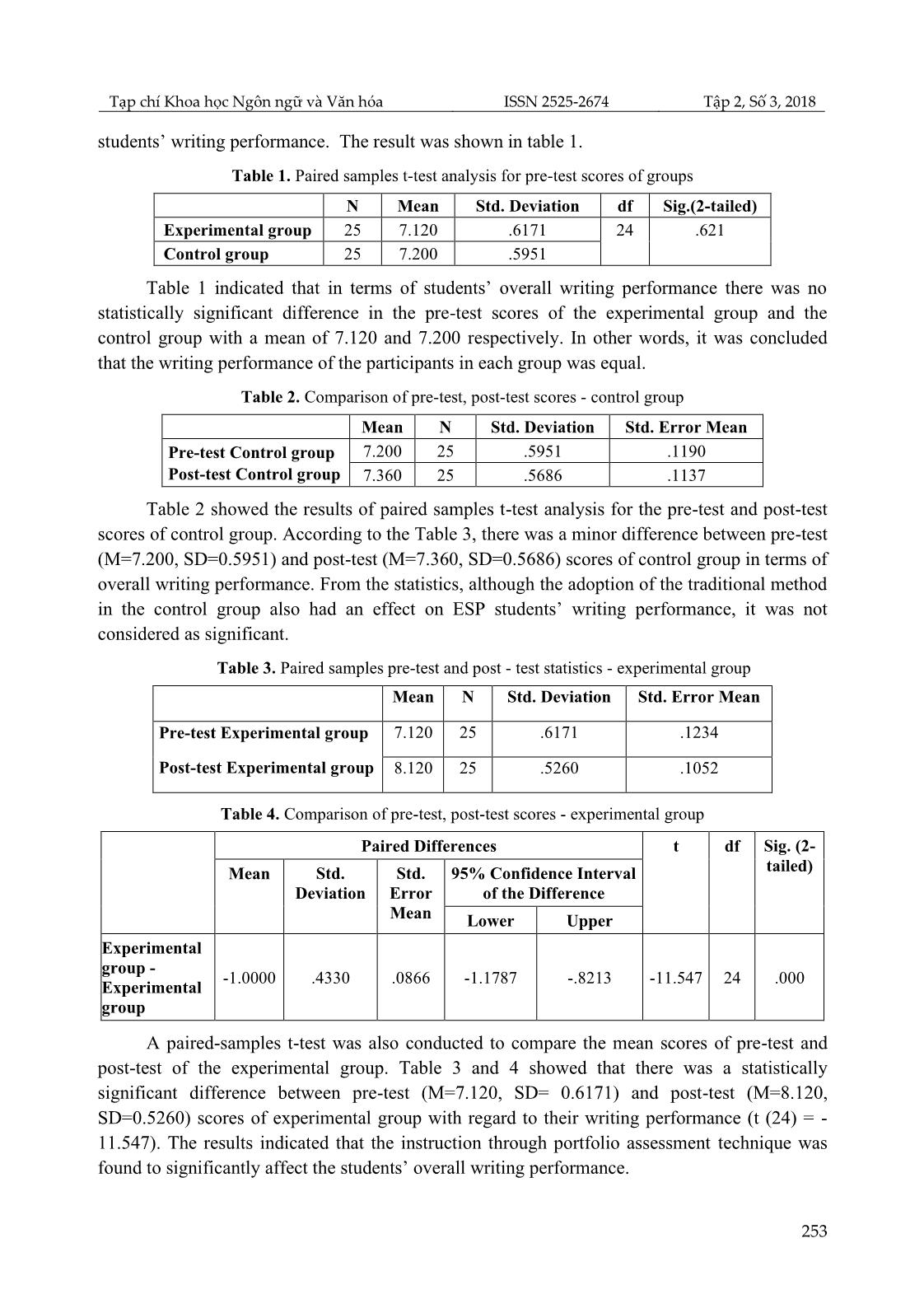
Trang 5
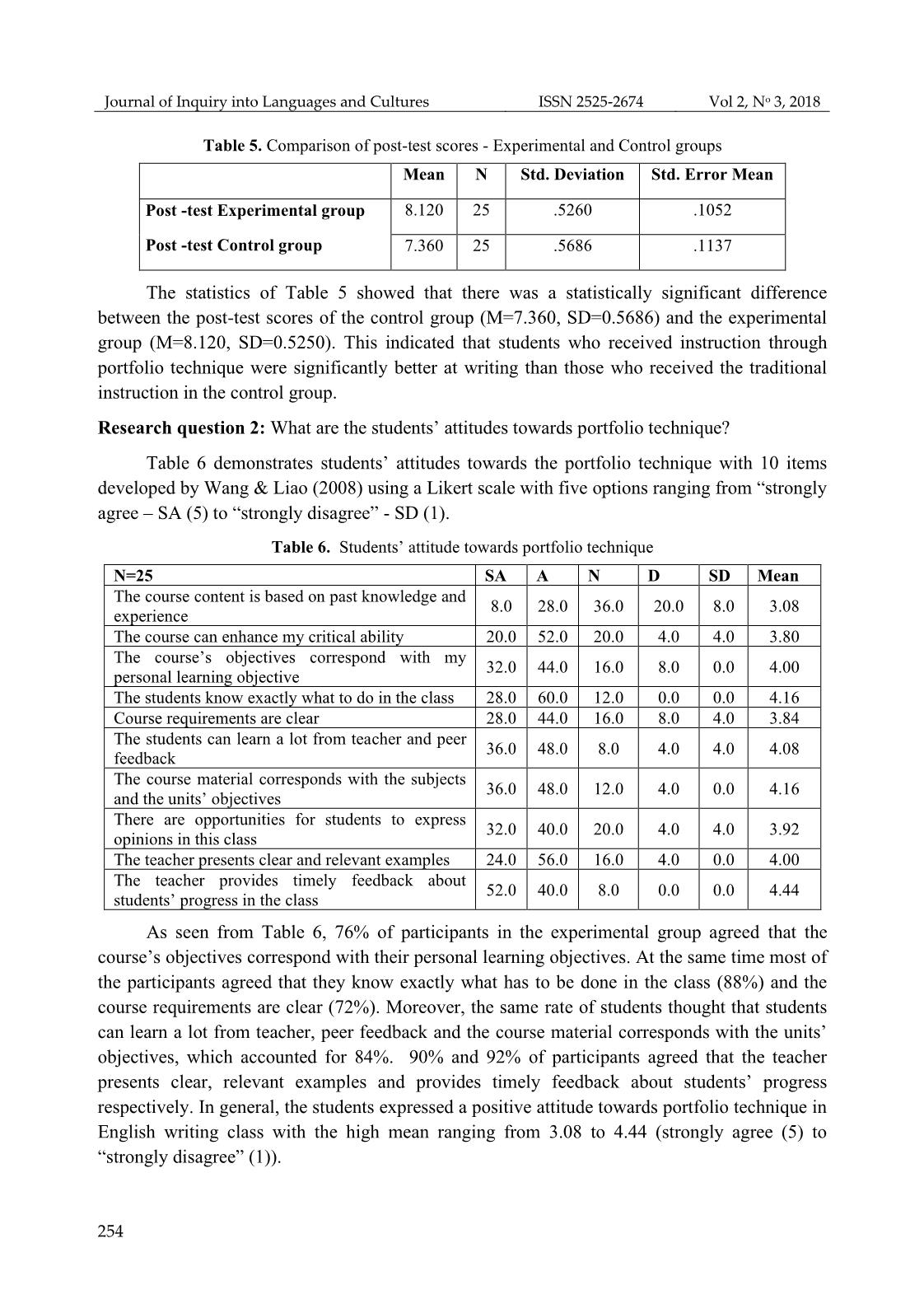
Trang 6
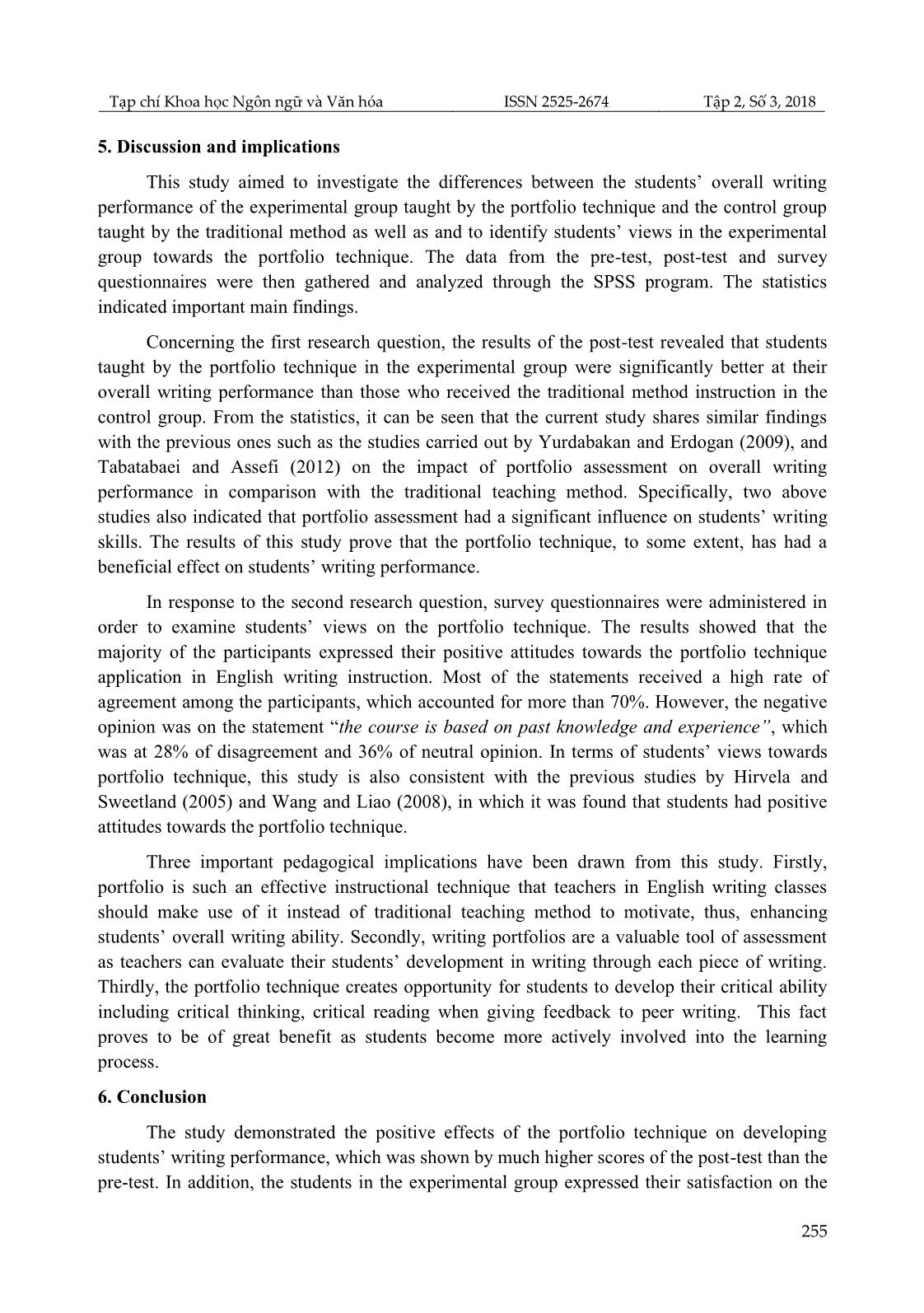
Trang 7
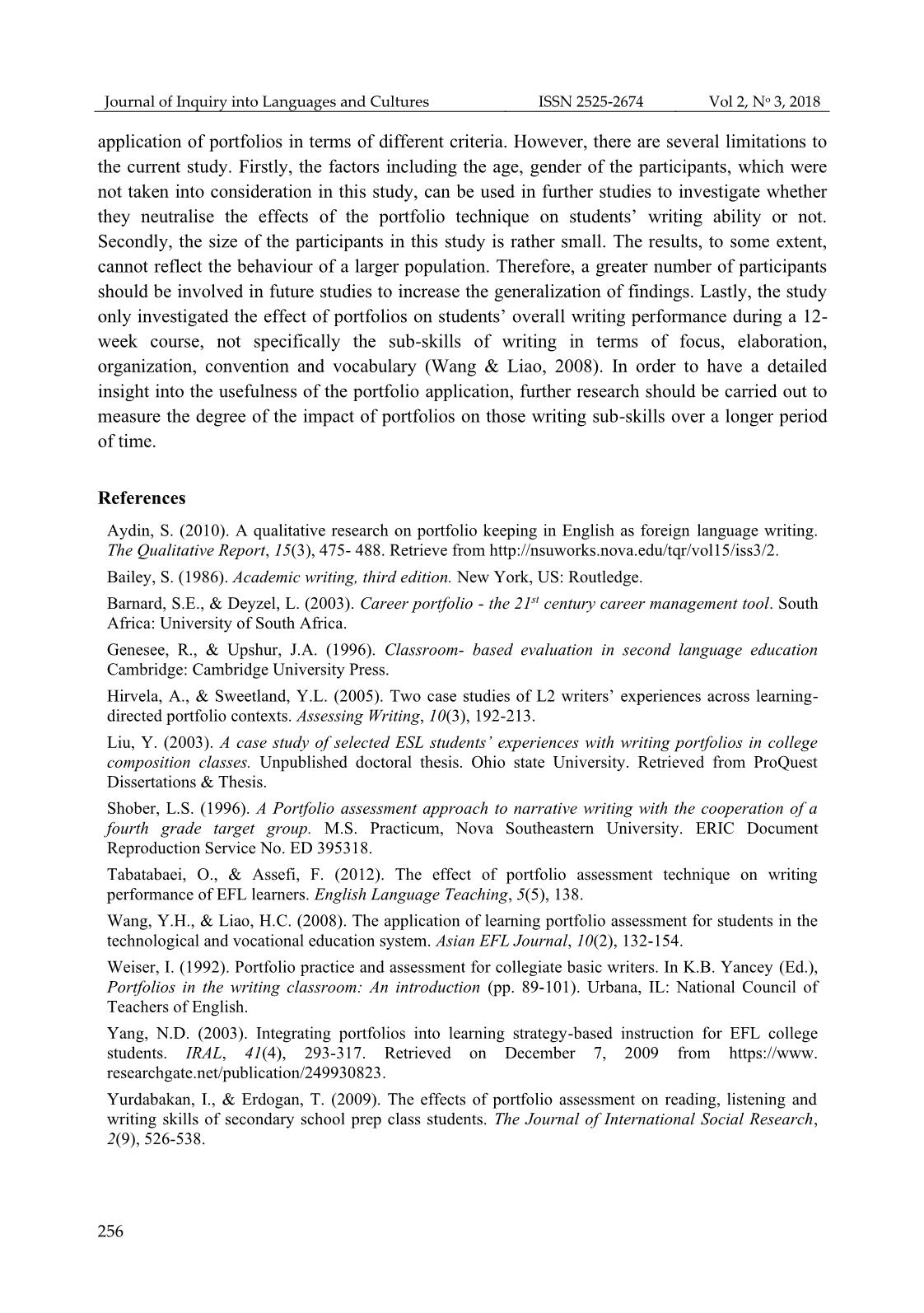
Trang 8
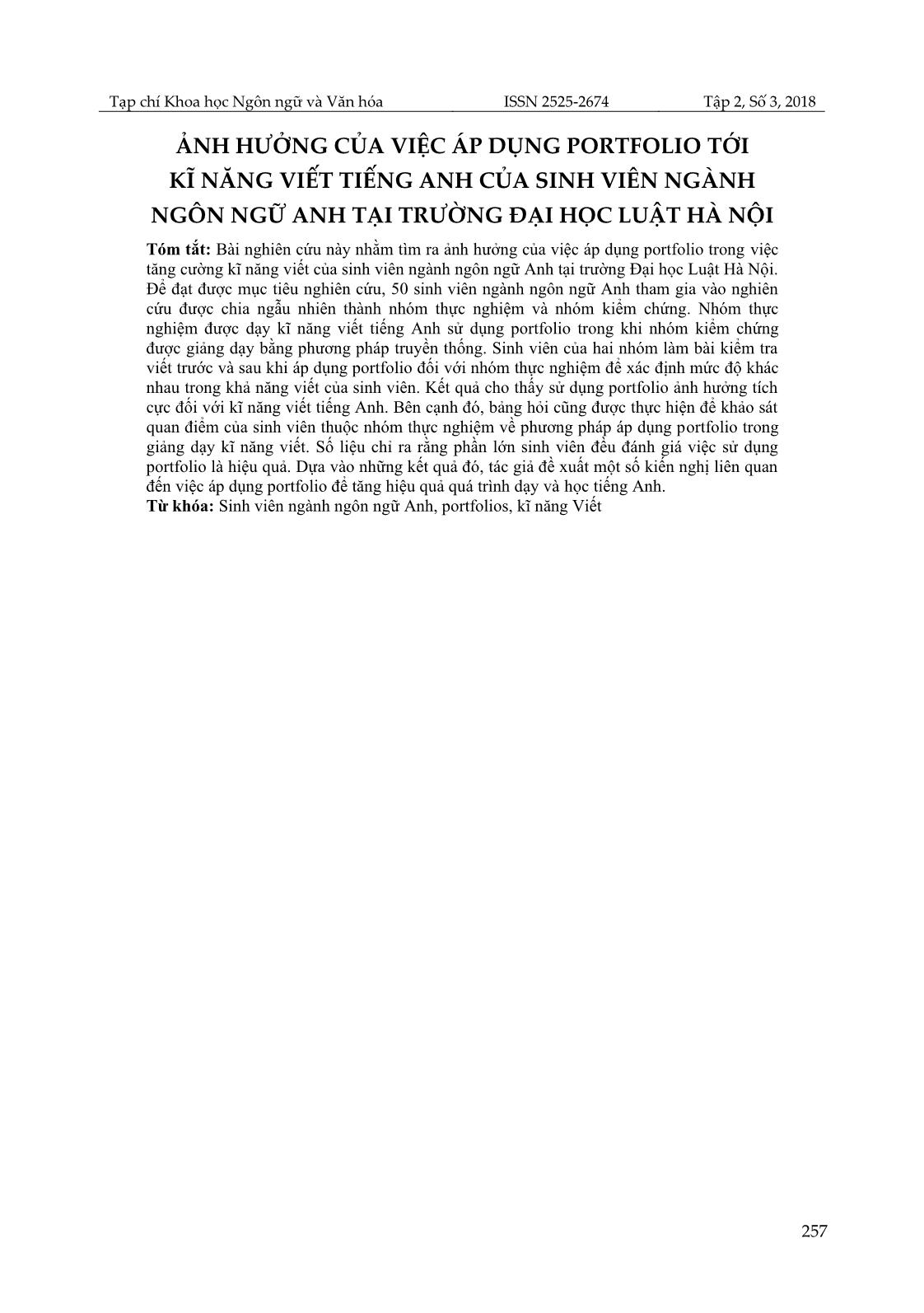
Trang 9
Tóm tắt nội dung tài liệu: The effects of portfolios on developing writing skills of english major students at Hanoi law university
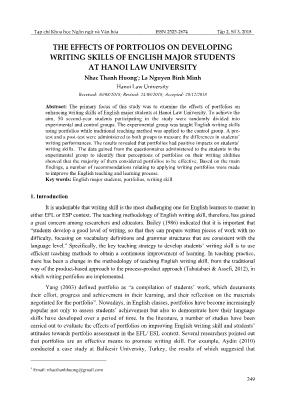
Tạp chí Khoa học Ngôn ngữ và Văn hóa ISSN 2525-2674 Tập 2, Số 3, 2018 249 THE EFFECTS OF PORTFOLIOS ON DEVELOPING WRITING SKILLS OF ENGLISH MAJOR STUDENTS AT HANOI LAW UNIVERSITY Nhac Thanh Huong*; La Nguyen Binh Minh Hanoi Law University Received: 30/08/2018; Revised: 24/09/2018; Accepted: 20/12/2018 Abstract: The primary focus of this study was to examine the effects of portfolios on enhancing writing skills of English major students at Hanoi Law University. To achieve the aim, 50 second-year students participating in the study were randomly divided into experimental and control groups. The experimental group was taught English writing skills using portfolios while traditional teaching method was applied to the control group. A pre- test and a post-test were administered to both groups to measure the differences in students’ writing performances. The results revealed that portfolios had positive impacts on students’ writing skills. The data gained from the questionnaires administered to the students in the experimental group to identify their perceptions of portfolios on their writing abilities showed that the majority of them considered portfolios to be effective. Based on the main findings, a number of recommendations relating to applying writing portfolios were made to improve the English teaching and learning process. Key words: English major students, portfolios, writing skill 1. Introduction It is undeniable that writing skill is the most challenging one for English learners to master in either EFL or ESP context. The teaching methodology of English writing skill, therefore, has gained a great concern among researchers and educators. Bailey (1986) indicated that it is important that “students develop a good level of writing, so that they can prepare written pieces of work with no difficulty, focusing on vocabulary definitions and grammar structures that are consistent with the language level.” Specifically, the key teaching strategy to develop students’ writing skill is to use efficient teaching methods to obtain a continuous improvement of learning. In teaching practice, there has been a change in the methodology of teaching English writing skill, from the traditional way of the product-based approach to the process-product approach (Tabatabaei & Assefi, 2012), in which writing portfolios are implemented. Yang (2003) defined portfolio as “a compilation of students’ work, which documents their effort, progress and achievement in their learning, and their reflection on the materials negotiated for the portfolio”. Nowadays, in English classes, portfolios have become increasingly popular not only to assess students’ achievement but also to demonstrate how their language skills have developed over a period of time. In the literature, a number of studies have been carried out to evaluate the effects of portfolios on improving English writing skill and students’ attitudes towards portfolio assessment in the EFL/ ESL context. Several researchers pointed out that portfolios are an effective means to promote writing skill. For example, Aydin (2010) conducted a case study at Balikesir University, Turkey, the results of which suggested that * Email: nhacthanhhuong@gmail.com Journal of Inquiry into Languages and Cultures ISSN 2525-2674 Vol 2, No 3, 2018 250 portfolios help learners improve vocabulary, grammar learning as well as develop proficiency skills. Similarly, the findings of Yurdabakan and Erdogan (2009) indicated that portfolio assessment had a significant effect on learners’ writing skill. It can be said that using portfolios in teaching and assessment was found to be of great benefit, providing complete pictures of students’ needs in foreign language teaching and learning. However, there have been limited studies on the effect of portfolios on EFL writing skill and students’ attitudes toward portfolio technique, in particular in English classes at University level in Vietnam. This situation is similar to that at Hanoi Law University where writing skill is a compulsory subject to legal English major students during three semesters. At this institution, using portfolios in the teaching and assessment of students’ development in English writing skill is encouraged. However, there has not been any research to identify the impact of using portfolios in developing students’ writing performance. This fact suggests a need for carrying out the research on the impact of portfolios as well as English major students’ attitudes towards the use of portfolios on improving their writing skills. The study, therefore, seeks to answer the two following research questions: 1. Do writing portfolios have an effect on the students’ achievement in their overall writing skill? 2. What are the students’ attitudes towards portfolio technique? 2. Theoretical framework 2.1. Portfolio and portfolio assessment There has been a number of ways to define portfolio in the literature. Barnard and Deyzel (2003) defined: “portfolio as a portable, systematic, purposeful collection of work, selected to provide information about attitude, level of development and growth during a given period of time. It is a powerful visual tool that provides evidence of self-assessment, personal reflections, learning, growth and development and a comprehensive and complex overview of skills”. To be more specific, a portfolio is defined as "a purposeful collection of students’ work that demonstrates their effort, progress and achievement in given area” (Genesee & Upshur, 1996). A writing portfolio, therefore, is a collection of student writing that is intended to demonstrate the writer’s development over the course of one or more academic terms. Currently, in EFL classes, teachers tend to prefer using the process approach in teaching writing skill to the product approach. In the process ... heir overall writing ability? Before the treatment, paired samples t-test was conducted in order to investigate whether or not there was any difference between the control and experimental groups in terms of Tạp chí Khoa học Ngôn ngữ và Văn hóa ISSN 2525-2674 Tập 2, Số 3, 2018 253 students’ writing performance. The result was shown in table 1. Table 1. Paired samples t-test analysis for pre-test scores of groups N Mean Std. Deviation df Sig.(2-tailed) Experimental group 25 7.120 .6171 24 .621 Control group 25 7.200 .5951 Table 1 indicated that in terms of students’ overall writing performance there was no statistically significant difference in the pre-test scores of the experimental group and the control group with a mean of 7.120 and 7.200 respectively. In other words, it was concluded that the writing performance of the participants in each group was equal. Table 2. Comparison of pre-test, post-test scores - control group Mean N Std. Deviation Std. Error Mean Pre-test Control group Post-test Control group 7.200 25 .5951 .1190 7.360 25 .5686 .1137 Table 2 showed the results of paired samples t-test analysis for the pre-test and post-test scores of control group. According to the Table 3, there was a minor difference between pre-test (M=7.200, SD=0.5951) and post-test (M=7.360, SD=0.5686) scores of control group in terms of overall writing performance. From the statistics, although the adoption of the traditional method in the control group also had an effect on ESP students’ writing performance, it was not considered as significant. Table 3. Paired samples pre-test and post - test statistics - experimental group Mean N Std. Deviation Std. Error Mean Pre-test Experimental group Post-test Experimental group 7.120 25 .6171 .1234 8.120 25 .5260 .1052 Table 4. Comparison of pre-test, post-test scores - experimental group Paired Differences t df Sig. (2- tailed) Mean Std. Deviation Std. Error Mean 95% Confidence Interval of the Difference Lower Upper Experimental group - Experimental group -1.0000 .4330 .0866 -1.1787 -.8213 -11.547 24 .000 A paired-samples t-test was also conducted to compare the mean scores of pre-test and post-test of the experimental group. Table 3 and 4 showed that there was a statistically significant difference between pre-test (M=7.120, SD= 0.6171) and post-test (M=8.120, SD=0.5260) scores of experimental group with regard to their writing performance (t (24) = - 11.547). The results indicated that the instruction through portfolio assessment technique was found to significantly affect the students’ overall writing performance. Journal of Inquiry into Languages and Cultures ISSN 2525-2674 Vol 2, No 3, 2018 254 Table 5. Comparison of post-test scores - Experimental and Control groups Mean N Std. Deviation Std. Error Mean Post -test Experimental group Post -test Control group 8.120 25 .5260 .1052 7.360 25 .5686 .1137 The statistics of Table 5 showed that there was a statistically significant difference between the post-test scores of the control group (M=7.360, SD=0.5686) and the experimental group (M=8.120, SD=0.5250). This indicated that students who received instruction through portfolio technique were significantly better at writing than those who received the traditional instruction in the control group. Research question 2: What are the students’ attitudes towards portfolio technique? Table 6 demonstrates students’ attitudes towards the portfolio technique with 10 items developed by Wang & Liao (2008) using a Likert scale with five options ranging from “strongly agree – SA (5) to “strongly disagree” - SD (1). Table 6. Students’ attitude towards portfolio technique N=25 SA A N D SD Mean The course content is based on past knowledge and experience 8.0 28.0 36.0 20.0 8.0 3.08 The course can enhance my critical ability 20.0 52.0 20.0 4.0 4.0 3.80 The course’s objectives correspond with my personal learning objective 32.0 44.0 16.0 8.0 0.0 4.00 The students know exactly what to do in the class 28.0 60.0 12.0 0.0 0.0 4.16 Course requirements are clear 28.0 44.0 16.0 8.0 4.0 3.84 The students can learn a lot from teacher and peer feedback 36.0 48.0 8.0 4.0 4.0 4.08 The course material corresponds with the subjects and the units’ objectives 36.0 48.0 12.0 4.0 0.0 4.16 There are opportunities for students to express opinions in this class 32.0 40.0 20.0 4.0 4.0 3.92 The teacher presents clear and relevant examples 24.0 56.0 16.0 4.0 0.0 4.00 The teacher provides timely feedback about students’ progress in the class 52.0 40.0 8.0 0.0 0.0 4.44 As seen from Table 6, 76% of participants in the experimental group agreed that the course’s objectives correspond with their personal learning objectives. At the same time most of the participants agreed that they know exactly what has to be done in the class (88%) and the course requirements are clear (72%). Moreover, the same rate of students thought that students can learn a lot from teacher, peer feedback and the course material corresponds with the units’ objectives, which accounted for 84%. 90% and 92% of participants agreed that the teacher presents clear, relevant examples and provides timely feedback about students’ progress respectively. In general, the students expressed a positive attitude towards portfolio technique in English writing class with the high mean ranging from 3.08 to 4.44 (strongly agree (5) to “strongly disagree” (1)). Tạp chí Khoa học Ngôn ngữ và Văn hóa ISSN 2525-2674 Tập 2, Số 3, 2018 255 5. Discussion and implications This study aimed to investigate the differences between the students’ overall writing performance of the experimental group taught by the portfolio technique and the control group taught by the traditional method as well as and to identify students’ views in the experimental group towards the portfolio technique. The data from the pre-test, post-test and survey questionnaires were then gathered and analyzed through the SPSS program. The statistics indicated important main findings. Concerning the first research question, the results of the post-test revealed that students taught by the portfolio technique in the experimental group were significantly better at their overall writing performance than those who received the traditional method instruction in the control group. From the statistics, it can be seen that the current study shares similar findings with the previous ones such as the studies carried out by Yurdabakan and Erdogan (2009), and Tabatabaei and Assefi (2012) on the impact of portfolio assessment on overall writing performance in comparison with the traditional teaching method. Specifically, two above studies also indicated that portfolio assessment had a significant influence on students’ writing skills. The results of this study prove that the portfolio technique, to some extent, has had a beneficial effect on students’ writing performance. In response to the second research question, survey questionnaires were administered in order to examine students’ views on the portfolio technique. The results showed that the majority of the participants expressed their positive attitudes towards the portfolio technique application in English writing instruction. Most of the statements received a high rate of agreement among the participants, which accounted for more than 70%. However, the negative opinion was on the statement “the course is based on past knowledge and experience”, which was at 28% of disagreement and 36% of neutral opinion. In terms of students’ views towards portfolio technique, this study is also consistent with the previous studies by Hirvela and Sweetland (2005) and Wang and Liao (2008), in which it was found that students had positive attitudes towards the portfolio technique. Three important pedagogical implications have been drawn from this study. Firstly, portfolio is such an effective instructional technique that teachers in English writing classes should make use of it instead of traditional teaching method to motivate, thus, enhancing students’ overall writing ability. Secondly, writing portfolios are a valuable tool of assessment as teachers can evaluate their students’ development in writing through each piece of writing. Thirdly, the portfolio technique creates opportunity for students to develop their critical ability including critical thinking, critical reading when giving feedback to peer writing. This fact proves to be of great benefit as students become more actively involved into the learning process. 6. Conclusion The study demonstrated the positive effects of the portfolio technique on developing students’ writing performance, which was shown by much higher scores of the post-test than the pre-test. In addition, the students in the experimental group expressed their satisfaction on the Journal of Inquiry into Languages and Cultures ISSN 2525-2674 Vol 2, No 3, 2018 256 application of portfolios in terms of different criteria. However, there are several limitations to the current study. Firstly, the factors including the age, gender of the participants, which were not taken into consideration in this study, can be used in further studies to investigate whether they neutralise the effects of the portfolio technique on students’ writing ability or not. Secondly, the size of the participants in this study is rather small. The results, to some extent, cannot reflect the behaviour of a larger population. Therefore, a greater number of participants should be involved in future studies to increase the generalization of findings. Lastly, the study only investigated the effect of portfolios on students’ overall writing performance during a 12- week course, not specifically the sub-skills of writing in terms of focus, elaboration, organization, convention and vocabulary (Wang & Liao, 2008). In order to have a detailed insight into the usefulness of the portfolio application, further research should be carried out to measure the degree of the impact of portfolios on those writing sub-skills over a longer period of time. References Aydin, S. (2010). A qualitative research on portfolio keeping in English as foreign language writing. The Qualitative Report, 15(3), 475- 488. Retrieve from Bailey, S. (1986). Academic writing, third edition. New York, US: Routledge. Barnard, S.E., & Deyzel, L. (2003). Career portfolio - the 21st century career management tool. South Africa: University of South Africa. Genesee, R., & Upshur, J.A. (1996). Classroom- based evaluation in second language education Cambridge: Cambridge University Press. Hirvela, A., & Sweetland, Y.L. (2005). Two case studies of L2 writers’ experiences across learning- directed portfolio contexts. Assessing Writing, 10(3), 192-213. Liu, Y. (2003). A case study of selected ESL students’ experiences with writing portfolios in college composition classes. Unpublished doctoral thesis. Ohio state University. Retrieved from ProQuest Dissertations & Thesis. Shober, L.S. (1996). A Portfolio assessment approach to narrative writing with the cooperation of a fourth grade target group. M.S. Practicum, Nova Southeastern University. ERIC Document Reproduction Service No. ED 395318. Tabatabaei, O., & Assefi, F. (2012). The effect of portfolio assessment technique on writing performance of EFL learners. English Language Teaching, 5(5), 138. Wang, Y.H., & Liao, H.C. (2008). The application of learning portfolio assessment for students in the technological and vocational education system. Asian EFL Journal, 10(2), 132-154. Weiser, I. (1992). Portfolio practice and assessment for collegiate basic writers. In K.B. Yancey (Ed.), Portfolios in the writing classroom: An introduction (pp. 89-101). Urbana, IL: National Council of Teachers of English. Yang, N.D. (2003). Integrating portfolios into learning strategy-based instruction for EFL college students. IRAL, 41(4), 293-317. Retrieved on December 7, 2009 from https://www. researchgate.net/publication/249930823. Yurdabakan, I., & Erdogan, T. (2009). The effects of portfolio assessment on reading, listening and writing skills of secondary school prep class students. The Journal of International Social Research, 2(9), 526-538. Tạp chí Khoa học Ngôn ngữ và Văn hóa ISSN 2525-2674 Tập 2, Số 3, 2018 257 ẢNH HƯỞNG CỦA VIỆC ÁP DỤNG PORTFOLIO TỚI KĨ NĂNG VIẾT TIẾNG ANH CỦA SINH VIÊN NGÀNH NGÔN NGỮ ANH TẠI TRƯỜNG ĐẠI HỌC LUẬT HÀ NỘI Tóm tắt: Bài nghiên cứu này nhằm tìm ra ảnh hưởng của việc áp dụng portfolio trong việc tăng cường kĩ năng viết của sinh viên ngành ngôn ngữ Anh tại trường Đại học Luật Hà Nội. Để đạt được mục tiêu nghiên cứu, 50 sinh viên ngành ngôn ngữ Anh tham gia vào nghiên cứu được chia ngẫu nhiên thành nhóm thực nghiệm và nhóm kiểm chứng. Nhóm thực nghiệm được dạy kĩ năng viết tiếng Anh sử dụng portfolio trong khi nhóm kiểm chứng được giảng dạy bằng phương pháp truyền thống. Sinh viên của hai nhóm làm bài kiểm tra viết trước và sau khi áp dụng portfolio đối với nhóm thực nghiệm để xác định mức độ khác nhau trong khả năng viết của sinh viên. Kết quả cho thấy sử dụng portfolio ảnh hưởng tích cực đối với kĩ năng viết tiếng Anh. Bên cạnh đó, bảng hỏi cũng được thực hiện để khảo sát quan điểm của sinh viên thuộc nhóm thực nghiệm về phương pháp áp dụng portfolio trong giảng dạy kĩ năng viết. Số liệu chỉ ra rằng phần lớn sinh viên đều đánh giá việc sử dụng portfolio là hiệu quả. Dựa vào những kết quả đó, tác giả đề xuất một số kiến nghị liên quan đến việc áp dụng portfolio để tăng hiệu quả quá trình dạy và học tiếng Anh. Từ khóa: Sinh viên ngành ngôn ngữ Anh, portfolios, kĩ năng Viết
File đính kèm:
 the_effects_of_portfolios_on_developing_writing_skills_of_en.pdf
the_effects_of_portfolios_on_developing_writing_skills_of_en.pdf

